|
|
|
|
|
|
|
|
|
|
|
|
|
 |
 |
 |
 |
|
 |
 |
 |
 |
|
|
Eagle Required: yes
Counselor: Dr Prunk
This is a good badge to work on over the summer. Scouts wishing to do the Family Life Merit Badge should contact Dr Prunk.
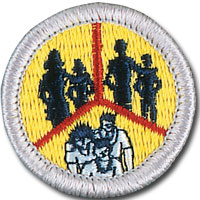 |
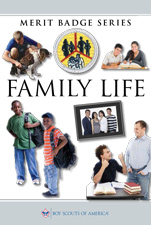
Family Life
BSA Supply No. 35830 |
The family is the basic unit of society and is important to both individuals and communities. The world is rapidly changing, making today's society much more complex than ever before. As Scouts earn this merit badge, they will realize why it is important to know more about family life and how to strengthen their families.
Requirements
- Prepare an outline on what a family is and discuss this with your merit badge counselor. Tell why families are important to individuals and to society. Discuss how the actions of one member can affect other members.
- List several reasons why you are important to your family and discuss this with your parents or guardians and with your merit badge counselor.
- Prepare a list of your regular home duties or chores (at least five) and do them for 90 days. Keep a record of how often you do each of them.
- With the approval of your parents or guardians and your merit badge counselor, decide on and carry out a project that you would do around the home that would benefit your family. Submit a report to your merit badge counselor outlining how the project benefited your family.
- Plan and carry out a project that involves the participation of your family. After completing the project, discuss the following with your merit badge counselor:
- The objective or goal of the project
- How individual members of your family participated
- The results of the project
- Do the following:
- Discuss with your merit badge counselor how to plan and carry out a family meeting.
- After this discussion, plan and carry out a family meeting to include the following subjects:
- Avoiding substance abuse, including tobacco, alcohol, and drugs, all of which negatively affect your health and well-being
- Understanding the growing-up process and how the body changes, and making responsible decisions dealing with sex
- Personal and family finances
- A crisis situation within your family
- The effect of technology on your family
- Good etiquette and manners
Discussion of each of these subjects will very likely carry over to more than one family meeting.
- Discuss the following with your counselor:
- Your understanding of what makes an effective father and why, and your thoughts on the father's role in the family
- Your understanding of the responsibilities of a parent
|
|
 |
 |
|
Icon
|
File Name
|
Comment
|
|
 |
Family-Life MB Workbook.pdf |
Merit Badge Workbokk |
|
|
 |
 |
 |
 |
 |
 |
 |
 |
|
 |
 |
 |
 |
|
|
Eagle Required: yes
Counselor: Dr Prunk
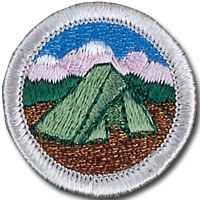 |

Camping
BSA Supply No. 35866 |
Camping is one of the best-known methods of the Scouting movement. When he founded the Scouting movement in the early 1900s, Robert Baden-Powell encouraged every Scout to learn the art of living out-of-doors. He believed a young person able to take care of himself while camping would have the confidence to meet life's other challenges, too.
Requirements
- Do the following:
- Explain to your counselor the most likely hazards you may encounter while participating in camping activities and what you should do to anticipate, help prevent, mitigate, and respond to these hazards.
- Show that you know first aid for and how to prevent injuries or illnesses that could occur while camping, including hypothermia, frostbite, heat reactions, dehydration, altitude sickness, insect stings, tick bites, snakebite, blisters, and hyperventilation.
- Learn the Leave No Trace principles and the Outdoor Code and explain what they mean. Write a personal and group plan for implementing these principles on your next outing.
- Make a written plan for an overnight trek and show how to get to your camping spot using a topographical map and compass OR a topographical map and a GPS receiver.
- Do the following:
- Make a duty roster showing how your patrol is organized for an actual overnight campout. List assignments for each member.
- Help a Scout patrol or a Webelos Scout unit in your area prepare for an actual campout, including creating the duty roster, menu planning, equipment needs, general planning, and setting up camp.
- Do the following:
- Prepare a list of clothing you would need for overnight campouts in both warm and cold weather. Explain the term “layering.”
- Discuss footwear for different kinds of weather and how the right footwear is important for protecting your feet.
- Explain the proper care and storage of camping equipment (clothing, footwear, bedding).
- List the outdoor essentials necessary for any campout, and explain why each item is needed.
- Present yourself to your Scoutmaster with your pack for inspection. Be correctly clothed and equipped for an overnight campout.
- Do the following:
- Describe the features of four types of tents, when and where they could be used, and how to care for tents. Working with another Scout, pitch a tent.
- Discuss the importance of camp sanitation and tell why water treatment is essential. Then demonstrate two ways to treat water.
- Describe the factors to be considered in deciding where to pitch your tent.
- Tell the difference between internal- and external-frame packs. Discuss the advantages and disadvantages of each.
- Discuss the types of sleeping bags and what kind would be suitable for different conditions. Explain the proper care of your sleeping bag and how to keep it dry. Make a comfortable ground bed.
- Prepare for an overnight campout with your patrol by doing the following:
- Make a checklist of personal and patrol gear that will be needed.
- Pack your own gear and your share of the patrol equipment and food for proper carrying. Show that your pack is right for quickly getting what is needed first, and that it has been assembled properly for comfort, weight, balance, size, and neatness.
- Do the following:
- Explain the safety procedures for
- Using a propane or butane/propane stove
- Using a liquid fuel stove
- Proper storage of extra fuel
- Discuss the advantages and disadvantages of different types of lightweight cooking stoves.
- Prepare a camp menu. Explain how the menu would differ from a menu for a backpacking or float trip. Give recipes and make a food list for your patrol. Plan two breakfasts, three lunches, and two suppers. Discuss how to protect your food against bad weather, animals, and contamination.
- Cook at least one breakfast, one lunch, and one dinner for your patrol from the meals you have planned for requirement 8c. At least one of those meals must be a trail meal requiring the use of a lightweight stove.
- Show experience in camping by doing the following:
- Camp a total of at least 20 nights at designated Scouting activities or events. One long-term camping experience of up to six consecutive nights may be applied toward this requirement. Sleep each night under the sky or in a tent you have pitched. If the camp provides a tent that has already been pitched, you need not pitch your own tent.
- On any of these camping experiences, you must do TWO of the following, only with proper preparation and under qualified supervision.
- Hike up a mountain, gaining at least 1,000 vertical feet.
- Backpack, snowshoe, or cross-country ski for at least 4 miles.
- Take a bike trip of at least 15 miles or at least four hours.
- Take a nonmotorized trip on the water of at least four hours or 5 miles.
- Plan and carry out an overnight snow camping experience.
- Rappel down a rappel route of 30 feet or more.
- Perform a conservation project approved by the landowner or land managing agency.
- Discuss how the things you did to earn this badge have taught you about personal health and safety, survival, public health, conservation, and good citizenship. In your discussion, tell how Scout spirit and the Scout Oath and Scout Law apply to camping and outdoor ethics.
|
|
 |
 |
|
Icon
|
File Name
|
Comment
|
|
 |
Camping MB Workbook.pdf |
Camping MB Workbook |
|
|
 |
 |
 |
 |
 |
 |
 |
 |
|
 |
 |
 |
 |
|
|
Eagle Required: yes
Counselor: Mr Sanford
This is a good badge to work on over the summer. Scouts wishing to work on the Hiking Merit Badge
should contact Mr Sanford
 |

Hiking
BSA Supply No. 35907 |
Hiking is a terrific way to keep your body and mind in top shape, both now and for a lifetime. Walking packs power into your legs and makes your heart and lungs healthy and strong. Exploring the outdoors challenges you with discoveries and new ideas. Your senses will improve as you use your eyes and ears to gather information along the way.
Requirements
- Do the following:
- Explain to your counselor the most likely hazards you may encounter while hiking, and what you should do to anticipate, help prevent, mitigate, and respond to these hazards.
- Show that you know first aid for injuries or illnesses that could occur while hiking, including hypothermia, heatstroke, heat exhaustion, frostbite, dehydration, sunburn, sprained ankle, insect stings, tick bites, snakebite, blisters, hyperventilation, and altitude sickness.
- Explain and, where possible, show the points of good hiking practices including the principles of Leave No Trace, hiking safety in the daytime and at night, courtesy to others, choice of footwear, and proper care of feet and footwear.
- Explain how hiking is an aerobic activity. Develop a plan for conditioning yourself for 10-mile hikes, and describe how you will increase your fitness for longer hikes.
- Make a written plan for a 10-mile hike. Include map routes, a clothing and equipment list, and a list of items for a trail lunch.
- Take five hikes, each on a different day, and each of 10 continuous miles. You may stop for as many short rest periods as needed, as well as one meal, during each hike, but not for an extended period (example: overnight). Prepare a hike plan for each hike.*
- Take a hike of 20 continuous miles in one day following a hike plan you have prepared. You may stop for as many short rest periods as needed, as well as one meal, but not for an extended period (example: overnight).*
- After each of the hikes (or during each hike if on one continuous "trek") in requirements 5 and 6, write a short report of your experience. Give dates and descriptions of routes covered, the weather, and interesting things you saw. Share this report with your merit badge counselor.
* The hikes in requirements 5 and 6 can be used in fulfilling Second Class (2a) and First Class (3) rank requirements, but only if Hiking merit badge requirements 1, 2, 3, and 4 have been completed to the satisfaction of your counselor. The hikes of requirements 5 and 6 cannot be used to fulfill requirements of other merit badges.
|
|
 |
 |
|
Icon
|
File Name
|
Comment
|
|
 |
Hiking MB Workbook 2013 Version.pdf |
Hiking Merit Badge Work Book |
|
|
 |
 |
 |
 |
 |
 |
 |
 |
|
 |
 |
 |
 |
|
|
Merit Badge Counselor: Dr Prunk
Eagle Required: No
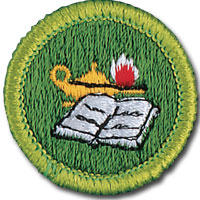 |

Reading
BSA Supply No. 35940 |
If you are interested in working on the Reading Merit Badge conctact Dr Prunk.
If you have ever wanted to go back in time or wished you could visit the future, if you are curious about the world, or if you are interested in how things work or like to learn new things, these are all reasons why you should want to read. Reading is fascinating. It's full of surprises. And it will take you places you can't get to in any other way.
Requirements
- Do EACH of the following:
- Learn how to search your library's card catalog or computerized catalog by author, title, and subject.
- With the assistance of your merit badge counselor or a librarian, select six books of four different types (such as poetry, drama/plays, fiction, nonfiction, biographies, etc.). Ask your librarian or counselor about award-winning books that are recommended for readers your age and include at least one of those titles.
- Find the books in the library catalog. With your counselor's or librarian's assistance, locate the books on the shelves.
- Read each book. Keep a log of your reading that includes the title of the book, the pages or chapters read, the date you completed them, and your thoughts about what you have read so far. Discuss your reading with your counselor. Using your log as a reference, explain why you chose each book and tell whether you enjoyed it and what it meant to you.
- Read about the world around you from any two sources - books, magazines, newspapers, the Internet (with your parent's permission), field manuals, etc. Topics may include sports, environmental problems, politics, social issues, current events, nature, religion, etc. Discuss what you have learned with your counselor.
- Do ONE of the following:
- From a catalog of your choice, fill out an order form for merchandise as if you intended to place an order. Share the completed form with your counselor and discuss it.
- With your paren's permission, locate at least five Web sites that are helpful for your Scouting or other activities. Write the Internet addresses of these sites in your log. Talk with your counselor or a librarian about safety rules for using the Internet.
- With your counselor's and your parent's permission, choose ONE of the following activities and devote at least four hours of service to that activity. Discuss your participation with your counselor.
- Read to a sick, blind, or homebound person in a hospital or in an extended-care facility.
- Perform volunteer work at your school library or a public library.
- Read stories to younger children, in a group or individually.
|
|
 |
 |
|
 |
 |
 |
 |
 |
 |
 |
 |
|
 |
 |
 |
 |
|
|
MB Counselor: Mr Pelham
Eagle Required: No
This is a good badge to work on over the summer. Scouts wishing to work on the Astronomy Merit Badge should contact Mr Pelham.
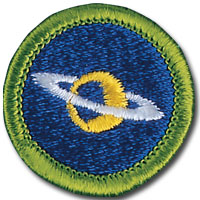 |

Astronomy
BSA Supply No. 610461 |
In learning about astronomy, Scouts study how activities in space affect our own planet and bear witness to the wonders of the night sky: the nebulae, or giant clouds of gas and dust where new stars are born; old stars dying and exploding; meteor showers and shooting stars; the moon, planets, and a dazzling array of stars.
Requirements
- Do the following:
- Explain to your counselor the most likely hazards you may encounter while participating in astronomy activities, and what you should do to anticipate, help prevent, mitigate, and respond to these hazards.
- Explain first aid for injuries or illnesses such as heat and cold reactions, dehydration, bites and stings, and damage to your eyes that could occur during observation.
- Describe the proper clothing and other precautions for safely making observations at night and in cold weather. Then explain how to safely observe the Sun, objects near the Sun, and the Moon.
- Explain what light pollution is and how it and air pollution affect astronomy.
- With the aid of diagrams (or real telescopes if available), do each of the following:
- Explain why binoculars and telescopes are important astronomical tools. Demonstrate or explain how these tools are used.
- Describe the similarities and differences of several types of astronomical telescopes, including at least one that observes light beyond the visible part of the spectrum (i.e., radio, X-ray, ultraviolet, or infrared).
- Explain the purposes of at least three instruments used with astronomical telescopes.
- Describe the proper care and storage of telescopes and binoculars both at home and in the field.
- Do the following:
- Identify in the sky at least 10 constellations, at least four of which are in the zodiac.
- Identify at least eight conspicuous stars, five of which are of magnitude 1 or brighter.
- Make two sketches of the Big Dipper. In one sketch, show the Big Dipper's orientation in the early evening sky. In another sketch, show its position several hours later. In both sketches, show the North Star and the horizon. Record the date and time each sketch was made.
- Explain what we see when we look at the Milky Way.
- Do the following:
- List the names of the five most visible planets. Explain which ones can appear in phases similar to lunar phases and which ones cannot, and explain why.
- Using the Internet (with your parent's permission) and other resources, find out when each of the five most visible planets that you identified in requirement 5a will be observable in the evening sky during the next 12 months, then compile this information in the form of a chart or table.
- Describe the motion of the planets across the sky.
- Observe a planet and describe what you saw.
- Do the following:
- Sketch the face of the Moon and indicate at least five seas and five craters. Label these landmarks.
- Sketch the phase and the daily position of the Moon, at the same hour and place, for four days in a row. Include landmarks on the horizon such as hills, trees, and buildings. Explain the changes you observe.
- List the factors that keep the Moon in orbit around Earth.
- With the aid of diagrams, explain the relative positions of the Sun, Earth, and the Moon at the times of lunar and solar eclipses, and at the times of new, first-quarter, full, and last-quarter phases of the Moon.
- Do the following:
- Describe the composition of the Sun, its relationship to other stars, and some effects of its radiation on Earth's weather and communications.
- Define sunspots and describe some of the effects they may have on solar radiation.
- Identify at least one red star, one blue star, and one yellow star (other than the Sun). Explain the meaning of these colors.
- With your counselor's approval and guidance, do ONE of the following:
- Visit a planetarium or astronomical observatory. Submit a written report, a scrapbook, or a video presentation afterward to your counselor that includes the following information:
- Activities occurring there
- Exhibits and displays you saw
- Telescopes and other instruments being used
- Celestial objects you observed
- Plan and participate in a three-hour observation session that includes using binoculars or a telescope. List the celestial objects you want to observe, and find each on a star chart or in a guidebook. Prepare an observing log or notebook. Show your plan, charts, and log or notebook to your counselor before making your observations. Review your log or notebook with your counselor afterward.
- Plan and host a star party for your Scout troop or other group such as your class at school. Use binoculars or a telescope to show and explain celestial objects to the group.
- Help an astronomy club in your community hold a star party that is open to the public.
- Personally take a series of photographs or digital images of the movement of the Moon, a planet, an asteroid, meteor, or a comet. In your visual display, label each image and include the date and time it was taken. Show all positions on a star chart or map. Show your display at school or at a troop meeting. Explain the changes you observed.
- Find out about three career opportunities in astronomy. Pick one and find out the education, training, and experience required for this profession. Discuss this with your counselor, and explain why this profession might interest you.
|
|
 |
 |
|
 |
 |
 |
 |
 |
 |
 |
 |
|
 |
 |
 |
 |
|
|
MB Counselor: Mr Pelham
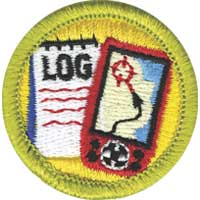 |

Geocaching
BSA Supply No. 610765 |
Eagle Require: No
This is a good badge to work on over the summer. Scouts wishing to work on the Geocaching Merit Badge should contact Mr Pelham
The word geocache is a combination of "geo," which means "earth," and "cache," which means "a hiding place." Geocaching describes a hiding place on planet Earth - a hiding place you can find using a GPS unit. A GPS (Global Positioning System) unit is an electronic tool that shows you where to go based on information it gets from satellites in space.
Requirements
- Do the following:
- Explain to your counselor the most likely hazards you may encounter while participating in geocaching activities, and what you should do to anticipate, help prevent, mitigate, and respond to these hazards.
- Discuss first aid and prevention for the types of injuries or illnesses that could occur while participating in geocaching activities, including cuts, scrapes, snakebite, insect stings, tick bites, exposure to poisonous plants, heat and cold reactions (sunburn, heatstroke, heat exhaustion, hypothermia), and dehydration.
- Discuss how to properly plan an activity that uses GPS, including using the buddy system, sharing your plan with others, and considering the weather, route, and proper attire.
- Discuss the following with your counselor:
- Why you should never bury a cache
- How to use proper geocaching etiquette when hiding or seeking a cache, and how to properly hide, post, maintain, and dismantle a geocache
- The principles of Leave No Trace as they apply to geocaching
- Explain the following terms used in geocaching: waypoint, log, cache, accuracy, difficulty and terrain ratings, attributes, trackable. Choose five additional terms to explain to your counselor.
- Explain how the Global Positioning System (GPS) works. Then, using Scouting's Teaching EDGE, demonstrate to your counselor the use of a GPS unit. Include marking and editing a waypoint, changing field functions, and changing the coordinate system in the unit.
- Do the following:
- Show you know how to use a map and compass and explain why this is important for geocaching.
- Explain the similarities and differences between GPS navigation and standard map-reading skills and describe the benefits of each.
- Explain the UTM (Universal Transverse Mercator) system and how it differs from the latitude/longitude system used for public geocaches.
- Show how to plot a UTM waypoint on a map. Compare the accuracy to that found with a GPS unit.
- Describe to your counselor the four steps to finding your first cache. Then mark and edit a waypoint.
- With your parent's permission*, go to www.geocaching.com. Type in your zip code to locate public geocaches in your area. Share with your counselor the posted information about three of those geocaches. Then, pick one of the three and find the cache.
- Do ONE of the following:
- If a Cache to Eagle ® series exists in your council, visit at least three of the locations in the series. Describe the projects that each cache you visit highlights, and explain how the Cache to Eagle ® program helps share our Scouting service with the public.
- Create a Scouting-related Travel Bug ® that promotes one of the values of Scouting. "Release" your Travel Bug into a public geocache and, with your parent's permission, monitor its progress at www.geocaching.com for 30 days. Keep a log, and share this with your counselor at the end of the 30-day period.
- Set up and hide a public geocache, following the guidelines in the Geocaching merit badge pamphlet. Before doing so, share with your counselor a six-month maintenance plan for the geocache where you are personally responsible for the first three months. After setting up the geocache, with your parent's permission, follow the logs online for 30 days and share them with your counselor.
- Explain what Cache In Trash Out (CITO) means, and describe how you have practiced CITO at public geocaches or at a CITO event. Then, either create CITO containers to leave at public caches, or host a CITO event for your unit or for the public.
- Plan a geohunt for a youth group such as your troop or a neighboring pack, at school, or your place of worship. Choose a theme, set up a course with at least four waypoints, teach the players how to use a GPS unit, and play the game. Tell your counselor about your experience, and share the materials you used and developed for this event.
|
|
 |
 |
|
 |
 |
 |
 |
 |
 |
 |
 |
|
 |
 |
|
|
Merit Badge Policies and Procedures
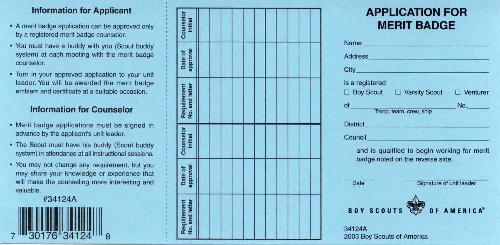
Boy Scout Merit Badge Blue Card
- Choose a merit badge to work on from those being offered by the troop or select one from the list.
- Find a Counselor. If the troop is currently offering the merit badge you will be assigned a merit badge councilor. If there is not a counselor for the Merit Badge you select to work on, discuss with your Scoutmaster and he will help find a Merit Badge Counselor.
- Contact the Counselor and ask him/her to counsel you.
- Get a blank blue card from the Scoutmaster or the Advancement Chairman.
- Completely fill out the Merit Badge blue card. The blue card should be completed in pen only. Complete with your information, the counselors name and the name of the Merit Badge. Some Merit Badge cards may be preprinted if a large amount of scouts are working on a specific Merit Badge.
District: Mark Twain
Council: Connecticut River Council
6. Bring the blue card to the Scoutmaster for his approval and signature. You may only begin work on the merit badge
after Scoutmaster signature is obtained on the front of the blue card. The Scoutmaster will record the merit badge in Troop Master.
- Work with the Counselor to complete the required components of the Merit Badge, regularly meeting with MB counselor, as indicated by your counselor, to complete the MB. Three people must be present at all meetings with the MB Counselor. The Counselor should hold onto your blue card while you are actively working on the Merit Badge. Merit Badges should be completed in a timely fashion. Any merit badges that have not been completed by the end of the Scouting year are to be turned over to the Scoutmaster and will be held until work is started again.
- The MB Counselor will sign the blue card once he/she is satisfied that you have met all of the requirements of that Merit Badge. The counselor will sign off on the backside of the card on the left and center leaf. The merit badge counselor will keep the last third of the blue card, “Counselor’s Record” and give the remaining two thirds to the Scout who will then turn it in to the Scout Master.
- Upon completion of the Merit Badge you must obtain the signature of the Scoutmaster. Once he is satisfied that all of the requirements have been met to complete the Merit Badge, he will put the final signature on the rear center panel of the card, update the Troop Master record and pass it on to the Advancements.
- The signed MB blue card then goes to the Advancements Chairman and they will record it in the computer and you will receive the completed blue card and the merit badge at the next Court of Honor. Completed and signed blue cards must be received by Advancement two weeks prior to the scheduled Court of Honor. The blue card must be saved. Put it in a safe place. DO NOT LOSE IT ! ! ! Each person holding a portion of the blue card, the Merit Badge Counselor, The Advancement Chair and the Scout must hold on to these cards for 7 years, or until the Scout makes Eagle. If anything should happen to the Scouts records, the blue cards serve as proof of earning merit badge towards the Eagle rank.
- The Merit Badge will be awarded at a Court of Honor. You will receive a card for each Merit Badge. This must be saved as well. Keep it separate from the blue card.
NOTES:
- The work MUST be the Scouts work; parents should help but let the scout earn it.
- It's not the badge that's important, but what is learned by completing the requirements.
|
|
 |
 |
|
 |
 |
 |
 |
 |
 |
 |
 |
|
 |
 |
 |
 |

|
Our Troop depends on parents and other adults to help deliver a quality Merit Badge Program to our Scouts as a part of its advancement program. The Merit Badge Counselor (MBC) plays a key role in the advancement of all Scouts. Whatever your area of expertise or interest - whether it is a special interest or hobby (basketry, leatherwork, coin collecting), a profession (veterinary medicine, aviation, engineering), or perhaps a life skill (cooking, personal management, communications, camping, fishing, swimming) - as a Merit Badge Counselor, you can help stir a young man's curiosity about that particular topic. By serving as a Merit Badge Counselor, you offer your time, knowledge, and other resources so that Scouts can explore a topic of interest.
Troop 68 has a long history of providing Merit Badge Counselors for each of the Eagle required badges plus dozens of others. Having that breadth of counselors helps our Scouts to advance and our Troop to prosper. The only way this tradition continues is with your assistance, so please become a Counselor!
Becoming a Merit Badge Counselor
Merit Badge Counselors are men and women of good character, age 18 or older, and recognized as having the skills and education in the subjects for with they are to serve as merit badge counselors, as well as having the ability to work with Scout-age boys.
- Complete BSA Youth Protection Training
The BSA requires all adult volunteer to complete Youth Protection Training (YPT) before interacting with the Scouts. This course is available online at www.myScouting.org. First time users will need to create an account. Your BSA ID can be added at a later time. When you have completed the course be sure to print a copy of your certificate. That certificate must be provided with your Adult Volunteer Application. Youth Protection Training must be retaken every two years.
- Complete an Adult Volunteer Application Form
This form is available below, from the Troop Scoutmaster or downloaded from http://www.scouting.org/formsThe Position Code is 42 and the position description is "Merit Badge Counselor". Even if you are already registered as a ASM or Comittee Member you must completed another application to become a Merit Badge Counselor. Consent to perform a criminal background check is mandatory as are personal references. There is no cost to you.
Note: Registering as a Merit Badge Counselor does not, in itself, register you as an Adult Leader (a.k.a, "Scouter"). Please see the Troop Committee or Scoutmaster if you are also interested in becoming an Assistant Scoutmaster or Committee Member.
- Complete a Merit Badge Counselor Form
This form is available below or from the Troop Scoutmaster. Click here for a complete list of Merit Badges. You have the option of limiting your instruction to only Troop 68 or you may choose to make yourself available to other troops in our District.
- Turn in your completed forms and Youth Protection certificate to the Troop Scoutmaster or Committee Chairman.
Getting Started
Being a MBC is not complicated but there are rules in place to ensure an enjoyable and safe experience for everyone involved. As you read the following information, keep in mind that BSA Advancement requirements are to be taken very literally. For example, if an instruction says "the Scout will..." then nobody but the Scout can. Similarly, the words Parent and Scout are never inter-changeable. In the end, only you the Merit Badge Counselor decides when the Scout has completed each and every requirement.
You should look over each of these BSA documents:
|
|
 |
 |
|
 |
 |
 |
 |
|
|
|
|
|
|
|
|
|